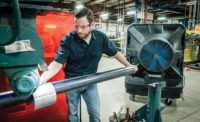The coronavirus (COVID-19) brings new and unprecedented risks to the workplace, one of the most notable being the exposure and transmission of the disease among people who are in close proximity to one another. However, the transmission of the virus is not the only risk that workers face in the time of the COVID-19 pandemic. With 2020 projected to be one of the hottest summers on record, the additional personal protective equipment (PPE) requirements can compound existing heat-related hazards.
Excessive heat is a serious health risk for workers, causing or contributing to heat stroke, heat exhaustion, heat cramps, heat rash, dizziness, slips, vision impairment, tool and equipment injuries, falling objects, burn injuries, toxic exposure, fire hazards and more. In 2015, heat exposure contributed to 37 work-related deaths and 2,830 nonfatal occupational injuries and illnesses, according to the Bureau of Labor Statistics.
Some studies have shown that adding on a face mask in high heat conditions may magnify these risks by decreasing visibility and restricting access to cool air, leading to elevated body temperature. Furthermore, wearing a face covering can make it more difficult to spot the signs of heat stress using the “buddy system.” To overcome these risks and ensure that workplaces remain safe from the ongoing hazard of COVID-19 transmission, it’s on employers, worksite managers and workers to be extra vigilant in spotting and preventing heat-related illnesses and injuries.
Know the risks
Heat stress is caused by a number of compounding factors, in addition to simply hot temperatures. High exertion and dehydration are two of the most common risks - others include non-breathable clothing, the tools that workers are using and the presence of multiple heat sources, such as hot tar, ovens or furnaces. Heat exposure can also be magnified and worsen existing health problems, including asthma, kidney failure, diabetes and heart disease. If a worker is over age 60, not physically fit or has a history of prior heat illness, these factors can all increase risk as well.
A lack of acclimatization also is a key factor in the risk of heat illness. The Occupational Safety and Health Administration (OSHA) reports that 50 to 70% of outdoor fatalities occur in the first few days of work in warm or hot environments because the body needs to gradually build a tolerance to high temperatures over time. This puts employees who are exposed to new environmental and occupational heat elements at heightened risk.
Heat safety 101
Given the additional heat-related complications of wearing a face mask, now more than ever, every person in a workplace should be trained and familiar with best practices for preventing, spotting and responding to heat illnesses.
The signs of heat stress and illness can take numerous forms. Dizziness, heavy sweating, fatigue, irritability, elevated heart rate, and even unconsciousness are common symptoms. Rashes, seizures, nausea, vomiting, and muscle pain can also indicate signs of heat illness.
To lower the risk of illness and injury, employers and site managers should encourage workers to pace themselves, understand their limits and take frequent breaks in the shade or indoors. They should also wear sun protection such as hats or sunscreen to prevent sunburn, and wear light-colored clothing and be provided proper PPE when handling tools and machinery. In addition to staying hydrated, workers are also advised to avoid beverages that are dehydrating such as coffee, alcohol, tea, and caffeinated sodas. Eating small meals containing fruits and fiber before and during work rather than larger, high-protein meals can also help sustain energy and hydration.
OSHA requires employers to provide safe working conditions for their employees, and this should include creating an illness prevention plan with training and supervision to help lower the risk of heat-related injury and illness. Employers should also provide first aid capabilities and work to create an optimally safe work environment by identifying and controlling heat hazards.
During the pandemic, it is important that COVID-19 safety precautions are incorporated into standard heat illness prevention practices. For example, though it is vital that employees stay hydrated, they should never share water bottles as it could spread the transmission of the virus. Likewise, though employees must take regular breaks to avoid overexertion in high heat, they should maintain social distancing. Because it is harder to spot the signs of heat stress when coworkers have their faces covered, workers should stay in verbal communication with one another to check in on how they are feeling in the heat throughout the workday.
In case of injury
If a worker sustains a heat-related injury on the job, immediately take steps to help cool them down and seek medical attention. After the worker has received care, they should inform their supervisor of the injury and file an accident report and workers’ compensation claim.
OSHA requires employers to report serious injuries, and employees are also able to report their injury directly. After a report has been filed, OSHA may initiate an inspection of the workplace. If a worker’s injury is the result of mismanagement of heat-related risks, workers have the right to explore their options for recovering losses stemming from the occupational disease or injury. In many states, like New York, workers usually cannot sue their employers to recover financial damages for on-the-job accidents or diseases. Instead, they can file a workers’ compensation claim to recover their losses. If the injury or disease occurs as a result of a third-party’s negligence, outside of an employer, the worker may wish to consider filing a personal injury lawsuit. Workers in these instances may benefit from seeking the guidance of an experienced personal injury lawyer who can review the details of their matter and advise them on their legal rights and remedies.
This summer is an unprecedented one in numerous ways. Not only is it projected to be one of the hottest on record, but the addition of COVID-19 safety precautions may increase the risk of workplace heat-related illnesses and injuries. With the proper awareness and safety procedures in place, many workplace heat-related injuries and illnesses can be prevented. For this reason, it is important for employers, worksite managers and employees to work together to create the best possible on-the-job work conditions for safety and success.



